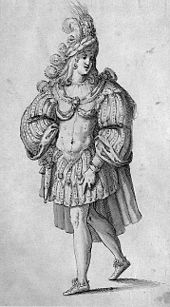Masque
Masque adalah bentuk perayaan sopan hiburan yang berkembang di Eropa pada abad ke-16 dan awal abad ke-17, meskipun dikembangkan lebih awal di Italia, dalam bentuk termasuk intermedio (versi publik dari topeng tersebut adalah kontes). Sebuah topeng melibatkan musik, tarian, nyanyian dan akting, dalam desain panggung yang rumit, di mana kerangka arsitektur dan kostumnya mungkin dirancang oleh seorang arsitek terkenal, untuk menghadirkan alegori hormat yang menyanjung pelindungnya. Aktor dan musisi profesional dipekerjakan untuk bagian berbicara dan menyanyi. Penyamar yang tidak berbicara atau menyanyi sering kali merupakan anggota istana: ratu Inggris Anne dari Denmark sering berdansa dengan para wanitanya dalam topeng antara tahun 1603 dan 1611, dan Henry VIII dan Charles I Inggris tampil di pesta topeng di istana mereka.[butuh rujukan] Dalam tradisi pesta topeng, Louis XIV dari Perancis menari dalam balet di Versailles dengan musik oleh Jean-Baptiste Lully.[1]

Perkembangan
The masque tradition developed from the elaborate pageants and courtly shows of ducal Burgundy in the late Middle Ages. Masques were typically a complimentary offering to the prince among his guests and might combine pastoral settings, mythological fables, and the dramatic elements of ethical debate. There would invariably be some political and social application of the allegory. Such pageants often celebrated a birth, marriage, change of ruler or a Royal Entry and invariably ended with a tableau of bliss and concord.
Masque imagery tended to be drawn from Classical rather than Christian sources, and the artifice was part of the Grand dance. Masque thus lent itself to Mannerist treatment in the hands of master designers like Giulio Romano or Inigo Jones.
The New Historians, in works like the essays of Bevington and Holbrook's The Politics of the Stuart Court Masque (1998),[2] have pointed out the political subtext of masques. At times, the political subtext was not far to seek: The Triumph of Peace, put on with a large amount of parliament-raised money by Charles I, caused great offence to the Puritans. Catherine de' Medici's court festivals, often even more overtly political, were among the most spectacular entertainments of her day, although the "intermezzi" of the Medici court in Florence could rival them.
Dumbshow
In English theatre tradition, a dumbshow is a masque-like interlude of silent mime usually with allegorical content that refers to the occasion of a play or its theme, the most famous being the dumbshow played out in Hamlet (III.ii). Dumbshows might be a moving spectacle, like a procession, as in Thomas Kyd's The Spanish Tragedy (1580s), or they might form a pictorial tableau, as one in the Shakespeare collaboration, Pericles, Prince of Tyre (III.i)—a tableau that is immediately explicated at some length by the poet-narrator, Gower.
Dumbshows were a Medieval element that continued to be popular in early Elizabethan drama, but by the time Pericles (c. 1607–08) or Hamlet (c. 1600–02) were staged, they were perhaps quaintly old-fashioned: “What means this, my lord?” is Ophelia's reaction. In English masques, purely musical interludes might be accompanied by a dumbshow.
Referensi
- Burden, Michael (1994), Garrick, Arne, and the Masque of Alfred, Edwin Mellon Press.
- Burden, Michael (1988). "A masque for politics; the masque of Alfred". Music Review. 41: 21–30.
- Hart, Vaughan (1994). Art and Magic in the Court of the Stuarts. London, Routledge.
- Ravelhofer, Barbara, (2006), The Early Stuart Masque: Dance, Costume, and Music, Oxford University Press.
- Sabol, Andrew J. (editor), (1959), Songs and dances from the Stuart Masque. An edition of sixty-three items of music for the English court masque from 1604 to 1641, Brown University Press.
- Sabol, Andrew J. (editor), (1982), Four hundred songs and dances from the Stuart Masque, Brown University Press.
- ^ 'History of the Masque Genre'
- ^ David Bevington and Peter Holbrook, editors, The Politics of the Stuart Court Masque 1998 ISBN 0-521-59436-7).